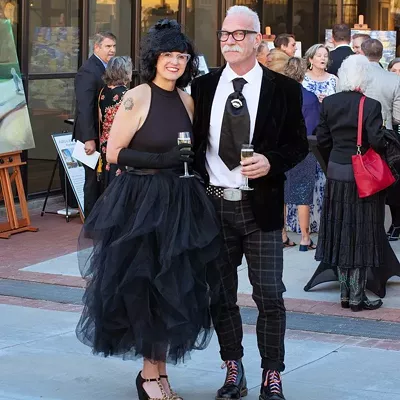When Abigail Felber was growing up outside Nashville, Tennessee, her older sister joined the Junior Cotillion.
"They learned etiquette rules, how to talk on the phone, which fork to use," says Felber, a 26-year-old artist and new MFA grad from the UA. "They had a dance. They had to show they could do the waltz and the foxtrot."
When it was Felber's turn to sign up, she flat out refused. She had no intention of training to be a well-behaved young Southern lady. But the rules in the etiquette book the Cotillion girls read stayed in her mind.
And those old behavior principles helped win a coveted slot in the "Arizona Biennial." She created a major installation, "Charm School for Marshmallow." Part video, part apron shrine, part chicken portraits in litho—that skewers old ideas about ladylike deportment.
The video plays in a continuous loop on a big screen that rises altar-like in a room of its own in the Tucson Museum of Art. Felber plays a well-dressed, well-coiffed and elegantly made-up 1950s woman. ("It's my Southern lady get-up," she says.) She even researched hairstyles of the era, and wrapped her hair into tight little pincurls. Her outfit is a rich ladylike pink, and the background is a proper pale blue.
In the four-and-a-half minute video, her character is trying to teach the rules of female behavior to her co-star, Marshmallow, a friend's real-life hen. Felber reads verbatim from Emily Post's "Etiquette: The Blue Book of Social Usage," published in 1950—the exact book that the Cotillion required her sister and the other young ladies to read.
Admonishing the hen never to powder her face in public, Felber's persona declares, "No woman should give evidence that her natural face is not satisfactory." A woman who dabs constantly at her face, "cheapens her behavior. And no one can be both cheap and a thoroughbred."
Marshmallow, not surprisingly, is wildly inattentive. Rather than taking in Post's tips, the hen alternates her time between shaking her head and pecking at the kernels of corn in a bowl.
These oddball ideas that Marshmallow ignores were still floating around in Felber's social milieu when she was growing up in the south.
"You had to be polite," Felber says. "And if you had an opinion you were supposed to keep it to yourself. Boys liked you better if you were smiling."
Her own parents, she hastens to add, were "not at all like that." They pushed their three daughters "to do what we needed to do."
Why did she cast a hen as her co-star in the video?
"A chicken never pays attention," she explains. "It's like a little rebel. There's a chicken inside all of us." Yet chickens can't talk back; similarly, she notes, humans who are rebellious at heart often don't speak their minds.
Felber had a little trouble shooting the video with the untamable hen. "No matter how I tried, she was never going to cooperate. I filmed at least 30 times."
The chickens hanging on the wall were easier to handle. Felber was a printmaking major at the UA ("Printmaking is my first and forever love," she says), and she used those skills to render comical portraits of chicken heads in black-and-white litho. Each chicken faces sideways, looking for all the world like a solemn ancestor, and the portraits are framed in ovals painted pink.
Below each portrait is a worn and faded apron, in flowers and checks, the kind worn by generations of mothers and grandmothers. Much of the installation feels humorous and satirical, but the homage to aprons turns the mood poignant. They evoke the women who labored for years under the old rules, seen and not heard in their kitchens, where they cared for their families uncelebrated and unheralded.
"I was trying to convey the roles of women today and past expectations, and what kind of pressures are still on women," says Felber. And she has even returned to the south. She's about to begin a new job teaching art at Volunteer State Community College in Tennessee.
"I'm still a little cynical but I do think things are changing."











